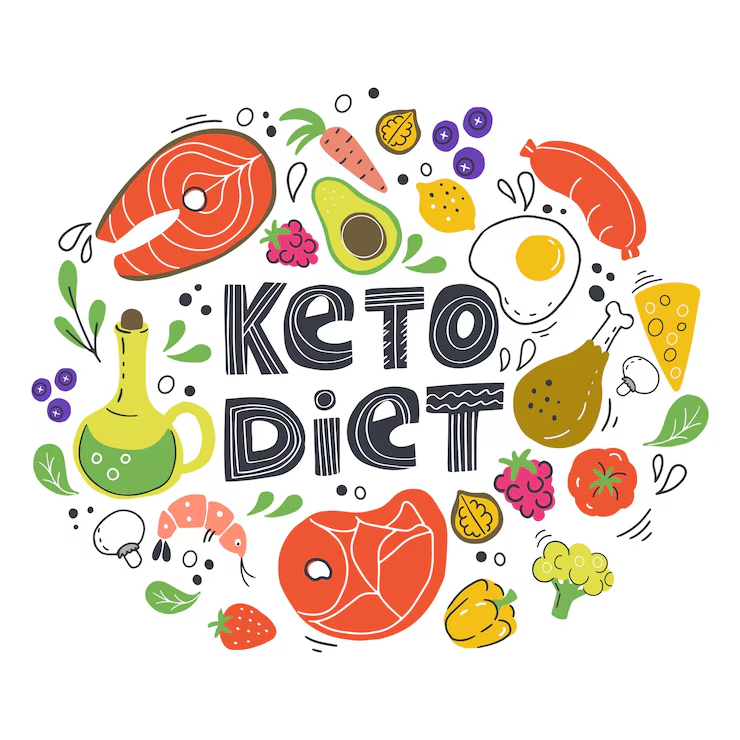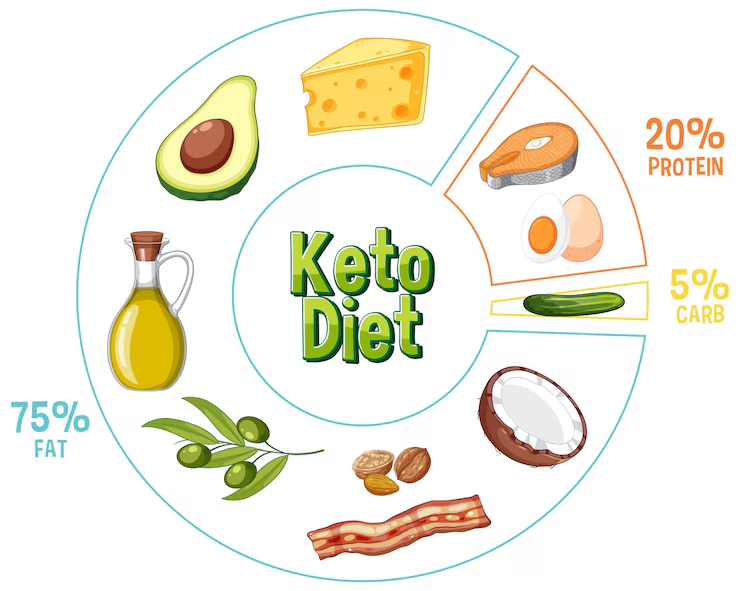In recent years, the ketogenic diet has become a popular method for weight loss and better health. Known for its low-carb, high-fat approach, the keto diet changes how the body uses energy. Instead of burning carbs, the body enters a state called ketosis, where it burns fat for fuel. This shift can help with weight management and boost energy levels.
The keto diet’s growing popularity is backed by many nutritionists and fitness experts. It’s not just about losing weight — people also follow it to manage blood sugar, improve mental clarity, and support heart health. Its ability to help with certain health conditions has made it appealing to a wide audience, from athletes to everyday health-conscious individuals.
If you’re considering starting, there are many keto plans to fit different needs. Whether you want a strict, standard keto approach or a more flexible version, this guide will help you choose the best one. Let’s explore how the ketogenic diet can work for your goals.
What is the Ketogenic Diet ?
The ketogenic diet, often called the keto diet, is a way of eating that focuses on very low carbohydrates and high fats. This change in food intake causes the body to switch its main source of energy. Instead of using carbohydrates for fuel, the body starts relying on fats. This shift helps change the way energy is used and stored in the body.
Under normal conditions, our bodies use glucose, which comes from carbohydrates, as the primary fuel for cells and organs. But when carb intake is significantly reduced, the body is forced to find another energy source. That’s when it begins to break down fat for energy.
This process leads to a state known as ketosis. In ketosis, the liver breaks down fats into ketones. These ketones become the new fuel, especially for the brain, which normally depends on glucose. This change can help increase energy levels and mental focus.
One of the major benefits of this shift is improved fat burning and better control of blood sugar. Many people find the keto diet helpful for managing weight and maintaining steady energy throughout the day.
Macronutrient Breakdown of the Keto Diet
Typically, the ketogenic diet consists of:
70-80% calories from fats (healthy fats like avocado, olive oil, nuts, and fatty fish)
10-20% calories from proteins (moderate protein intake to preserve muscle mass)
5-10% calories from carbohydrates (usually under 50 grams per day)
By maintaining these ratios, the body remains in ketosis, encouraging fat loss and other metabolic benefits.

Importance of the Ketogenic Diet
Sustainable and Long-Term Fat Reduction: In contrast to short-term fad diets that often result in temporary weight loss, the ketogenic diet encourages the body to rely on fat as its primary energy source. This metabolic adaptation supports consistent and sustainable fat reduction over time, without requiring severe calorie deficits or enduring feelings of hunger.
Enhanced Regulation of Blood Glucose and Insulin Activity: By significantly decreasing carbohydrate consumption, the ketogenic diet contributes to improved control of blood glucose and insulin levels. This is particularly beneficial for individuals experiencing insulin resistance, prediabetes, or type 2 diabetes. Stabilized blood sugar levels also minimize sudden energy dips and reduce cravings for sugary foods.
Improved Cognitive Performance and Mental Sharpness: As the brain efficiently utilizes ketones produced during ketosis, the ketogenic diet is believed to promote enhanced cognitive abilities. Many individuals report noticeable improvements in mental focus, memory retention, and overall clarity, with reduced experiences of mental fatigue or brain fog.
Therapeutic Potential for Neurological and Autoimmune Conditions: Initially developed to treat epilepsy, the ketogenic diet has demonstrated potential therapeutic benefits for managing neurological disorders such as Alzheimer’s disease, Parkinson’s disease, and multiple sclerosis. Its anti-inflammatory properties may also offer support for individuals with autoimmune disorders.
Support for Hormonal and Metabolic Stability: The ketogenic diet can assist in balancing key hormones related to appetite regulation, metabolism, and stress. It may positively influence thyroid function and improve lipid profiles, contributing to enhanced metabolic well-being and overall hormonal harmony.
Health Benefits of the Ketogenic Diet
Let’s explore the many scientifically supported benefits of the keto diet in greater detail:
Effective and Sustained Weight Reduction through Fat Metabolism: The ketogenic diet facilitates significant weight loss by transforming the body’s primary energy source from carbohydrates to stored fat. This metabolic state, known as ketosis, not only enhances fat oxidation but also suppresses appetite, increases metabolic rate, and promotes the breakdown of adipose tissue.
Enhanced Cardiovascular Health and Lipid Profile: Contrary to outdated beliefs about high-fat diets, the ketogenic diet has demonstrated improvements in cardiovascular wellness. It elevates HDL (beneficial cholesterol), reduces triglyceride levels, minimizes the density of LDL particles (making them less atherogenic), and supports healthy blood pressure regulation.
Improved Glycemic Control and Diabetes Management: The ketogenic diet plays a pivotal role in stabilizing blood sugar levels. It effectively lowers fasting glucose, boosts insulin responsiveness, and often decreases the need for diabetes-related medications. This makes it particularly valuable for individuals with type 2 diabetes or those at risk.
Cognitive and Neurological Advantages: Ketones produced through the ketogenic diet provide an efficient energy source for the brain, reducing oxidative stress and inflammation. These properties support neurological conditions such as drug-resistant epilepsy, Alzheimer’s disease, Parkinson’s disease, migraines, and cognitive decline.
Anti-Inflammatory Properties and Disease Prevention: By reducing oxidative damage and chronic inflammation, the ketogenic diet contributes to better health outcomes. Its anti-inflammatory effects have been linked to the prevention and management of several conditions, including cancer, cardiovascular disease, and autoimmune disorders.
Improved Energy Stability and Physical Endurance: Once the body becomes keto-adapted, the ketogenic diet provides consistent energy without the fluctuations associated with carbohydrate intake. Many endurance athletes report enhanced stamina and performance due to the efficient use of fat for fuel.
Balanced Hormonal Activity and Enhanced Skin Health: The ketogenic diet may regulate key hormones that influence metabolism, mood, and reproductive health. Many users report benefits such as reduced acne, improved symptoms of PCOS, and better hormonal balance, leading to enhanced mood and clearer skin.
Top Ketogenic Diet Plans
There are many variations of the ketogenic diet, each tailored to different needs, lifestyles, and goals. Here are the top 7 ketogenic diet plans to consider:
Standard Ketogenic Diet (SKD)

The Standard Ketogenic Diet (SKD) is the most commonly followed form of the ketogenic diet. It typically consists of a high-fat, moderate-protein, and very low-carbohydrate eating plan. The goal is to reduce carbohydrate intake to around 5–10% of daily calories, allowing the body to enter a state of ketosis.
In ketosis, the body begins to burn fat for energy instead of carbohydrates. This shift helps in efficient fat burning and supports weight loss. The Standard Ketogenic Diet is often used by people looking to lose weight, control blood sugar, or improve overall metabolic health.
Many individuals choose the Standard Ketogenic Diet because of its simplicity and proven results. It’s especially effective for those new to keto, offering a structured approach to achieving fat loss and better energy levels by staying consistent with low-carb, high-fat meals.
What it is: The classic keto diet that emphasizes high fat, moderate protein, and very low carbs.
Macros: 70-75% fat, 20% protein, 5-10% carbs
Who it’s for: Beginners and those seeking general weight loss and metabolic health benefits.
Targeted Ketogenic Diet (TKD)
The Targeted Ketogenic Diet (TKD) is a variation of the ketogenic diet that allows for added carbohydrates around workout times. It is designed for individuals who engage in regular high-intensity exercise and need extra fuel for performance. This approach helps balance energy needs while still promoting fat-burning through ketosis.
In TKD, people follow a standard low-carb, high-fat ketogenic diet but consume a small amount of fast-digesting carbs 30–60 minutes before exercise. The goal is to provide quick energy for workouts without kicking the body out of ketosis for long. After the activity, the body quickly returns to fat-burning mode.
The Targeted Ketogenic Diet is ideal for athletes and active individuals who want to maintain the benefits of the ketogenic diet while improving workout performance. It offers flexibility for fitness goals while keeping the body mostly in a ketogenic state.
Macros: Similar to SKD, but carbs are timed around physical activity.
Who it’s for: Active individuals or athletes who need extra carbs for performance but want to stay in ketosis most of the time.
Cyclical Ketogenic Diet (CKD)

The Cyclical Ketogenic Diet (CKD) is a version of the ketogenic diet that alternates between low-carb and high-carb days. It is mainly used by athletes or bodybuilders who want to boost performance while enjoying the fat-burning benefits of ketosis. This cycle helps refill glycogen stores without interrupting long-term ketosis too much.
In CKD, individuals typically follow a strict ketogenic diet for 5–6 days, followed by 1–2 days of higher carbohydrate intake. The high-carb phase is meant to restore energy levels and support intense training sessions. After the carb days, the body is guided back into ketosis by resuming the low-carb routine.
This method is useful for those who need more flexibility or engage in heavy physical activity. The Cyclical Ketogenic Diet allows users to benefit from the ketogenic diet while also meeting specific athletic or metabolic needs.
Macros:
Keto days: 70-75% fat, 20% protein, 5-10% carbs
Carb days: higher carbs (up to 150-200g), low fat
Who it’s for: Athletes or people who do intense training sessions and want to replenish glycogen stores periodically.
High-Protein Ketogenic Diet
The High-Protein Ketogenic Diet is a variation of the ketogenic diet that includes more protein while still keeping carbohydrates very low. This version is often followed by individuals looking to preserve muscle mass while losing fat. It’s especially useful for athletes, bodybuilders, or those with higher protein needs.
In this approach, the typical macronutrient ratio is about 60% fat, 35% protein, and 5% carbs. Unlike the standard ketogenic diet, which is moderate in protein, the high-protein version provides enough protein to support muscle repair and maintenance without disrupting ketosis.
The High-Protein Ketogenic Diet allows the body to stay in fat-burning mode while supporting lean body mass. It’s ideal for those who want to lose weight but also maintain strength and energy. This plan combines the benefits of the ketogenic diet with the added support of protein for active lifestyles.
Macros: 60-65% fat, 30% protein, 5-10% carbs
Who it’s for: Those who want to maintain or build muscle mass, such as bodybuilders or older adults.
Lazy or Dirty Keto

Lazy or Dirty Keto is a relaxed version of the ketogenic diet that focuses mainly on keeping carbohydrate intake low, without paying much attention to the quality of food or exact macronutrient ratios. People following this method often eat processed or fast foods, as long as they stay within their carb limit.
Unlike the standard ketogenic diet, which encourages whole, nutrient-rich foods, Dirty Keto allowed foods high in unhealthy fats and low in nutritional value. This can include items like bacon, cheese, sausage, or keto-labeled snacks that fit the carb goal but may lack vitamins and minerals.
While Lazy or Dirty Keto may still lead to weight loss and ketosis, it may not support long-term health. It can be useful for beginners who want a simple way to start the ketogenic diet, but it’s best to transition toward cleaner food choices for better results.
Macros: Standard keto macros, but includes processed foods or fast foods that fit macros.
Who it’s for: People who want the benefits of keto with more flexibility, though it’s not recommended for long-term health.
Vegan or Vegetarian Keto
The Vegan or Vegetarian Keto is a plant-based version of the ketogenic diet that focuses on high-fat, low-carb eating while avoiding animal products. It is designed for those who follow a vegetarian or vegan lifestyle but still want the benefits of ketosis, such as fat burning and steady energy.
Instead of meat and dairy, this version of the ketogenic diet relies on plant-based fats like nuts, seeds, avocados, coconut oil, and olive oil. Protein sources may include tofu, tempeh, and low-carb plant-based protein powders. Carb intake is still kept very low to maintain ketosis.
Following a Vegan or Vegetarian ketogenic diet requires careful planning to ensure proper nutrition, especially for protein, vitamin B12, and iron. However, it offers a unique way to combine the benefits of plant-based eating with the fat-burning effects of ketosis.
Macros: Similar to SKD, but protein from plant sources.
Who it’s for: Vegans or vegetarians who want to follow a ketogenic lifestyle.
Mediterranean Keto

The Mediterranean Keto is a healthy variation of the ketogenic diet that combines low-carb eating with the heart-friendly foods of the Mediterranean lifestyle. It focuses on whole, unprocessed ingredients while maintaining the fat-burning benefits of ketosis. This approach is ideal for people who want a balanced, long-term eating plan.
Unlike the standard ketogenic diet, which may include processed meats and dairy, the Mediterranean Keto emphasizes healthy fats like olive oil, avocados, nuts, and fatty fish. It also includes plenty of non-starchy vegetables, herbs, and moderate amounts of lean protein. Red meat and unhealthy fats are kept to a minimum.
This version of the ketogenic diet not only supports weight loss but also promotes heart health and overall wellness. It offers a more natural and nutritious way to follow keto, making it a great choice for those who care about both health and flavor.
Macros: Standard keto macros, focusing on Mediterranean-approved fats and proteins.
Who it’s for: People who want keto benefits alongside heart-healthy, nutrient-dense Mediterranean foods.
How to Start the Ketogenic Diet : Practical Tips
Calculate your macros: Use online keto calculators to estimate your ideal fat, protein, and carb intake.
Stock up on keto-friendly foods: Focus on healthy fats (avocado, olive oil, nuts), moderate proteins (meat, fish, eggs), and low-carb veggies (leafy greens, broccoli).
Avoid high-carb foods: Bread, pasta, sugar, grains, and most fruits.
Stay hydrated: Keto can cause water loss; drink plenty of water and replenish electrolytes.
Plan meals and snacks: To avoid slipping into carb-rich foods.
Monitor ketone levels: Using urine strips, breath analyzers, or blood meters to confirm ketosis.
Be patient: It takes 2-7 days to enter ketosis, and symptoms like the “keto flu” may occur initially but fade.
Potential Side Effects and Considerations
Keto flu: Temporary flu-like symptoms when starting keto.
Nutrient deficiencies: Careful planning needed to avoid lack of vitamins and minerals.
Not suitable for everyone: Pregnant women, people with certain medical conditions, or those on medications should consult a doctor.
Sustainability: Keto requires lifestyle changes and commitment.
Conclusion

In summary, the Ketogenic Diet stands out as a transformative nutritional approach with far-reaching benefits for weight loss, metabolic health, and cognitive function. By shifting the body’s fuel source from carbohydrates to fats, it promotes efficient fat burning, stabilizes blood sugar levels, and supports hormonal balance.
Whether you choose the standard ketogenic diet or one of its many variations like the targeted or cyclical keto plans, this diet can be tailored to fit diverse lifestyles and health goals. While starting a ketogenic diet may come with initial adjustments, the long-term health rewards are compelling—from improved heart health and reduced inflammation to enhanced mental clarity and energy levels.
Ultimately, the ketogenic diet is not just a fad but a scientifically backed lifestyle choice that empowers you to take control of your health. If embraced mindfully, it can pave the way for lasting wellness and vitality.
FAQs
Q.1 What is the ketogenic diet and how does it work ?
The ketogenic diet is a low-carb, high-fat eating plan that shifts your body’s primary energy source from glucose (carbs) to ketones (fat). By drastically reducing carbohydrate intake, your body enters a metabolic state called ketosis, where it burns fat for fuel instead of sugar.
Q.2 What foods can I eat on a ketogenic diet ?
You can eat high-fat foods like avocados, nuts, seeds, olive oil, butter, fatty fish, and moderate amounts of protein such as meat, eggs, and cheese. Low-carb vegetables like leafy greens, broccoli, and cauliflower are also encouraged, while carbs like bread, pasta, sugar, and most fruits should be avoided.
Q.3 How long does it take to enter ketosis ?
Typically, it takes 2 to 7 days of following a strict ketogenic diet to enter ketosis. This can vary based on individual metabolism, activity level, and carb intake.
Q.4 Can the ketogenic diet help with medical conditions ?
Yes, keto has been used to manage epilepsy and shows promise in improving conditions like type 2 diabetes, neurological disorders, and metabolic syndrome due to its effects on blood sugar and inflammation.
Q.5 Are there any side effects of the ketogenic diet ?
Some people experience “keto flu” during the first week, with symptoms like fatigue, headache, and irritability. Staying hydrated, replenishing electrolytes, and gradually reducing carbs can help minimize side effects.

